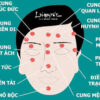Reading Physiognomy: Interpreting Lips Shape and Curvature
Welcome to our website dedicated to the fascinating practice of physiognomy, where we explore how the shape and curvature of the lips can provide insights into one’s personality and characteristics. Lips are not only a physical feature but also a unique expression of one’s individuality. By observing and analyzing the shape and curvature of the lips, we can uncover hidden aspects of a person’s nature.

- Lip Shape:
The shape of the lips can vary greatly from person to person, and each shape carries its own distinct meaning. Let’s explore some common lip shapes and their potential interpretations:
a) Full Lips: Individuals with full lips are often associated with traits such as sensuality, passion, and a charismatic personality. They may possess a strong presence and have a natural ability to attract and captivate others.
b) Thin Lips: Thin-lipped individuals are often characterized as analytical, detail-oriented, and precise. They tend to be logical thinkers who excel in tasks that require focus and attention to detail.
c) Round Lips: Round lips are often seen as a symbol of warmth, friendliness, and a nurturing nature. People with round lips are often empathetic, compassionate, and enjoy connecting with others on an emotional level.
d) Heart-shaped Lips: Lips that resemble the shape of a heart are often associated with individuals who are romantic, affectionate, and sentimental. They may have a deep appreciation for beauty and value emotional connections in their relationships.
- Lip Curvature:
The curvature of the lips, specifically the upward or downward curve, can also reveal unique aspects of a person’s personality. Here are a few common interpretations:
a) Upward Curved Lips: Individuals with lips that curve upwards are often seen as optimistic, cheerful, and enthusiastic. They tend to have a positive outlook on life and radiate joy and happiness to those around them.
b) Downward Curved Lips: Lips that curve downward are often associated with seriousness, introspection, and a more reserved nature. These individuals may have a contemplative and thoughtful approach to life and value depth and introspection in their interactions.
- Individual Interpretation:
It is important to remember that the interpretation of lip shape and curvature should be done with sensitivity and respect for each individual’s unique characteristics. Physiognomy provides insights into general tendencies and traits but should not be used to make definitive judgments about someone’s personality.
Seeking Professional Advice:
Physiognomy is an ancient practice that can vary across cultures and personal beliefs. The interpretations provided on this website are meant to offer a general understanding and should not replace professional advice or personal experiences. If you have specific concerns or questions about your own lip features, it is recommended to consult with qualified professionals for an accurate assessment and guidance.
Explore our website to delve deeper into the captivating world of physiognomy and uncover the meanings behind lip shapes and curvatures. Embrace the uniqueness of your lips and discover the fascinating insights they can provide.
Disclaimer: The information provided on this website is for educational and entertainment purposes only. It should not be used as a substitute for professional advice or diagnosis. Always consult with qualified professionals for any concerns or questions you may have.
Note: Physiognomy is a practice that may vary across cultures and personal beliefs. The information provided on this website is a general overview and may differ from specific cultural practices or interpretations.

